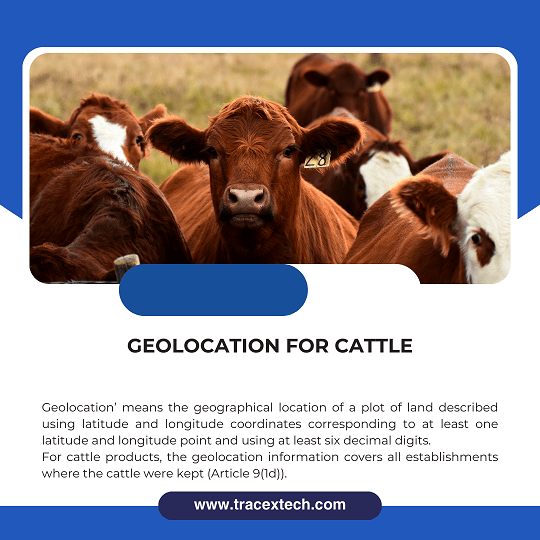Contact: +91 99725 24322 |
Menu
Menu
Quick summary: Explore the roadmap to sustainability and compliance for the leather industry under the EU Deforestation Regulation (EUDR). Discover how to tackle challenges such as traceability, data integration, and regulatory navigation, and learn how advanced technology solutions can support your journey towards a deforestation-free supply chain.

The leather industry is no stranger to the pressures of sustainability. With consumers increasingly demanding eco-friendly products and stricter regulations emerging, businesses are feeling the heat. Among the latest regulatory developments, EUDR Leather is a critical requirement that compliance and sustainability heads need to understand and prepare for. This regulation is set to reshape supply chains, and its impact on the leather industry will be significant.
Cattle farming is recognized as a leading cause of deforestation. Additionally, it plays a substantial role in the transformation of natural habitats like grasslands and savannahs. Although beef production is the main impetus for cattle raising, the leather sector has a crucial chance to promote positive change.
Navigating the complex landscape of traceability and proving that leather products aren’t linked to deforestation can be daunting. As brands strive to meet these rigorous standards, the need for a clear, actionable roadmap to EUDR compliance becomes evident.
Key Takeaways
The European Union Deforestation Regulation (EUDR), introduced as part of the EU’s broader strategy to combat global deforestation, aims to ensure that products placed on the EU market do not contribute to deforestation or forest degradation. This regulation specifically targets commodities such as soy, palm oil, wood, and, crucially for the leather industry, cattle, which is directly linked to deforestation through land clearing for livestock farming.
For the leather industry, this means that all products containing leather or leather-derived materials must comply with EUDR’s requirements. Companies need to demonstrate that their supply chains are free from deforestation-related activities, requiring robust due diligence and transparency measures.
At present, the sector is just beginning to address issues related to deforestation and land conversion. Companies and retailers that rely on leather need to promptly reform their lengthy, intricate, and frequently unclear supply chains, as these complexities hinder their ability to trace the origins of their raw materials.
Leather production has long been associated with environmental issues, particularly deforestation. The demand for cattle hides, a primary raw material for leather, has led to extensive land clearing, especially in regions like the Amazon. This has resulted in the loss of biodiversity, disruption of indigenous communities, and significant contributions to climate change.
Historically, the leather industry has faced criticism for its environmental footprint, leading to increasing calls for more sustainable practices. The EUDR is a direct response to these concerns, aiming to mitigate the industry’s role in deforestation.
The Deforestation-Free Call to Action for Leather is a collaborative effort designed to inspire brands to take measures against deforestation and the alteration of natural ecosystems tied to leather production. This initiative seeks to safeguard wildlife habitats and biodiversity, maintain carbon reserves to combat climate change, and uphold human rights.
The EUDR brings several implications for the leather industry, from supply chain management to market access. Compliance heads and sustainability leaders must understand these challenges to navigate them effectively.
The European Union Deforestation Regulation (EUDR) is poised to have a profound impact on global trade and conservation efforts. By enforcing strict due diligence requirements on companies importing commodities like palm oil, soy, and beef, the EUDR aims to significantly reduce the EU’s contribution to worldwide deforestation

Therefore only companies purchasing raw, part processed, or finished leather for processing or trading are in scope NOT companies producing, purchasing, or retailing finished products containing leather.
One of the most significant challenges posed by the EUDR is the requirement for leather supply chain transparency. Companies must trace the origins of their leather products to ensure they do not contribute to deforestation. This means not just knowing where the leather comes from but also understanding the entire journey of the raw materials, including the cattle’s grazing lands. To ensure compliance with the EUDR, businesses in the leather industry must implement robust traceability systems that can track the origin and journey of their products.
For many companies, especially those with complex global supply chains, achieving this level of transparency can be daunting. However, it’s essential for compliance with the EUDR and for maintaining consumer trust.
Non-compliance with the EUDR can result in severe consequences, including fines, market exclusion, and damage to brand reputation. The regulation requires companies to conduct due diligence, which involves assessing and mitigating the risks of deforestation in their supply chains. This process can be resource-intensive, requiring significant investment in monitoring and reporting systems.
Moreover, the EUDR’s requirements are likely to evolve, potentially becoming more stringent over time. Companies must be prepared to adapt to these changes, which may include additional documentation, audits, and third-party verification.
Complying with the EUDR is not just about avoiding penalties—it’s also about securing market access. The EU is a major market for leather products, and non-compliance could lead to losing access to this lucrative market. Moreover, as consumers become more environmentally conscious, they are increasingly likely to favor brands that demonstrate a commitment to sustainability.
Brands that proactively comply with the EUDR can enhance their reputation as sustainability leaders, differentiating themselves from competitors. This can lead to increased consumer loyalty, stronger partnerships, and even the ability to command higher prices for eco-friendly products.

The first step towards leather EUDR compliance is conducting a thorough audit of your supply chain. This involves mapping out every stage of the supply chain, from raw material sourcing to final product manufacturing. Understanding where your leather comes from and how it is processed is crucial for identifying potential deforestation risks.
During this process, you should work closely with suppliers to gather accurate and detailed information. This might require on-the-ground assessments, satellite monitoring, and collaboration with local communities and NGOs to verify that your supply chain is deforestation-free.
Technology plays a vital role in achieving the level of traceability required by the EUDR. Blockchain, for example, can be used to create a transparent and tamper-proof record of the leather supply chain. This technology allows companies to trace the origins of their products back to the source, ensuring that every step of the process is documented and verifiable.
Other technologies, such as satellite imaging and geospatial analysis, can help monitor land use changes and detect deforestation in real-time. By integrating these technologies into your supply chain management, you can enhance your ability to comply with the EUDR and respond quickly to any potential risks.
Ensuring EUDR compliance is not something that can be achieved in isolation. It requires close collaboration with your suppliers, who are often the first line of defense against deforestation. Establishing strong relationships with suppliers and setting clear expectations for sustainability is essential.
This collaboration might involve working together on sustainable sourcing initiatives, providing training and resources to help suppliers meet compliance standards, and implementing joint monitoring and reporting mechanisms. By building a network of responsible suppliers, you can create a more resilient and sustainable supply chain.
Compliance with the EUDR will require new skills and knowledge, both within your organization and across your supply chain. Investing in training and capacity building is crucial for ensuring that everyone involved understands the requirements and how to meet them.
This might include training on new technologies, such as blockchain and satellite monitoring, as well as education on the environmental and social impacts of deforestation. By building capacity within your organization and among your suppliers, you can create a culture of sustainability that supports long-term compliance.
The EUDR Compliance Platform can effectively address these challenges in the leather industry through several key functionalities:
1. Real-Time Traceability: By leveraging blockchain technology, the platform ensures real-time, end-to-end traceability of leather products. This addresses the challenge of linking hides to individual cattle and helps maintain transparency throughout the supply chain, even as cattle are moved long before slaughter.
2. Enhanced Record-Keeping: The platform simplifies and automates record-keeping processes, reducing the administrative burden and associated costs. It integrates various data sources, including ear tagging and slaughterhouse records, to provide comprehensive traceability and compliance documentation.
3.Data Integration and Legal Compliance: The platform facilitates the integration of existing cattle data into the leather supply chain. It also supports compliance with local regulations by allowing for adjustments and updates based on regional legal requirements, ensuring that the data used for environmental tracking is accurate and up to date.
4. Satellite Monitoring Systems: It offers integration with satellite monitoring and data collection tools to evaluate both direct and indirect suppliers. This improves batch-level traceability by moving towards individual animal tracking, making it easier to assess and mitigate the environmental impact of the leather supply chain.
5. Regulatory Navigation: The platform helps businesses navigate the complex and varied legal frameworks across different countries. It provides guidance on compliance with EUDR standards, helping companies adapt to inconsistent regulations and ensuring that land use for cattle and other commodities aligns with sustainability goals.
While the EUDR presents challenges, it also offers opportunities for the leather industry to innovate and lead in sustainability. By going beyond mere compliance, companies can turn these challenges into competitive advantages.
The EUDR represents a significant shift in how the leather industry must approach sustainability and compliance. While the challenges are considerable, they also present opportunities for innovation and leadership in sustainability.
By understanding the implications of the EUDR, auditing and enhancing your supply chain, leveraging technology, and collaborating with suppliers, you can ensure compliance and maintain your competitive edge. Moreover, by going beyond compliance and embracing sustainable practices, you can turn these challenges into opportunities, positioning your brand as a leader in the future of leather.
As we move forward, the companies that succeed will be those that see the EUDR not just as a regulatory hurdle, but as a catalyst for positive change. By taking proactive steps today, you can ensure that your business is not only compliant but also thriving in a more sustainable future.
The EU Deforestation Regulation (EUDR) requires companies to ensure that their products do not contribute to deforestation. For the leather industry, this means implementing traceability systems to prove that leather products are sourced from deforestation-free areas, impacting both sourcing practices and market access in the EU.
Leather companies can achieve EUDR compliance by implementing end-to-end traceability systems, conducting rigorous supplier due diligence, and using technology like blockchain for tracking leather origins. Partnering with compliance experts can also help streamline the process and ensure adherence to regulations.
EUDR compliance not only helps businesses avoid penalties but also enhances brand reputation, opens up access to the European market, and aligns with global sustainability trends. It positions leather companies as leaders in ethical sourcing and contributes to long-term business resilience.
